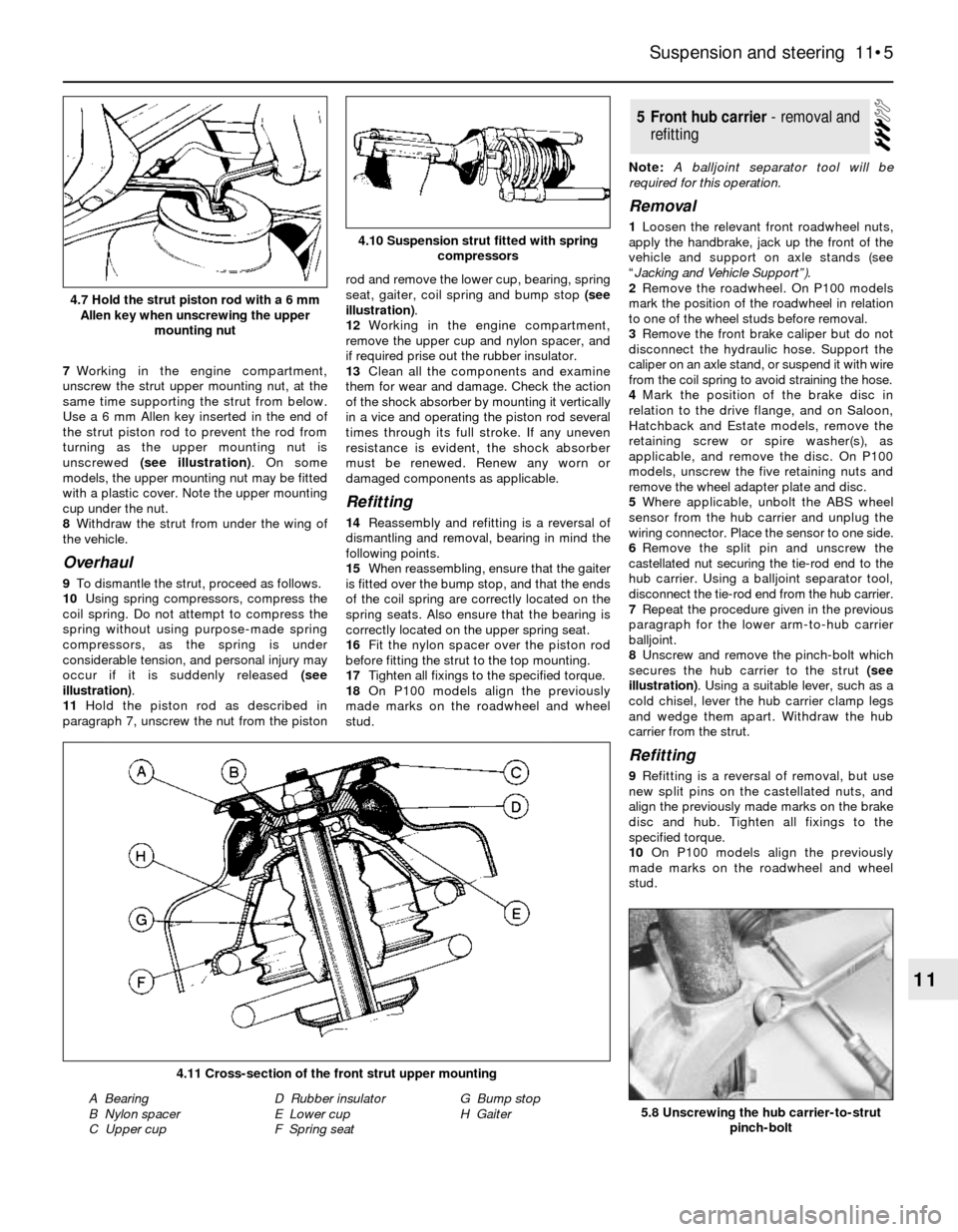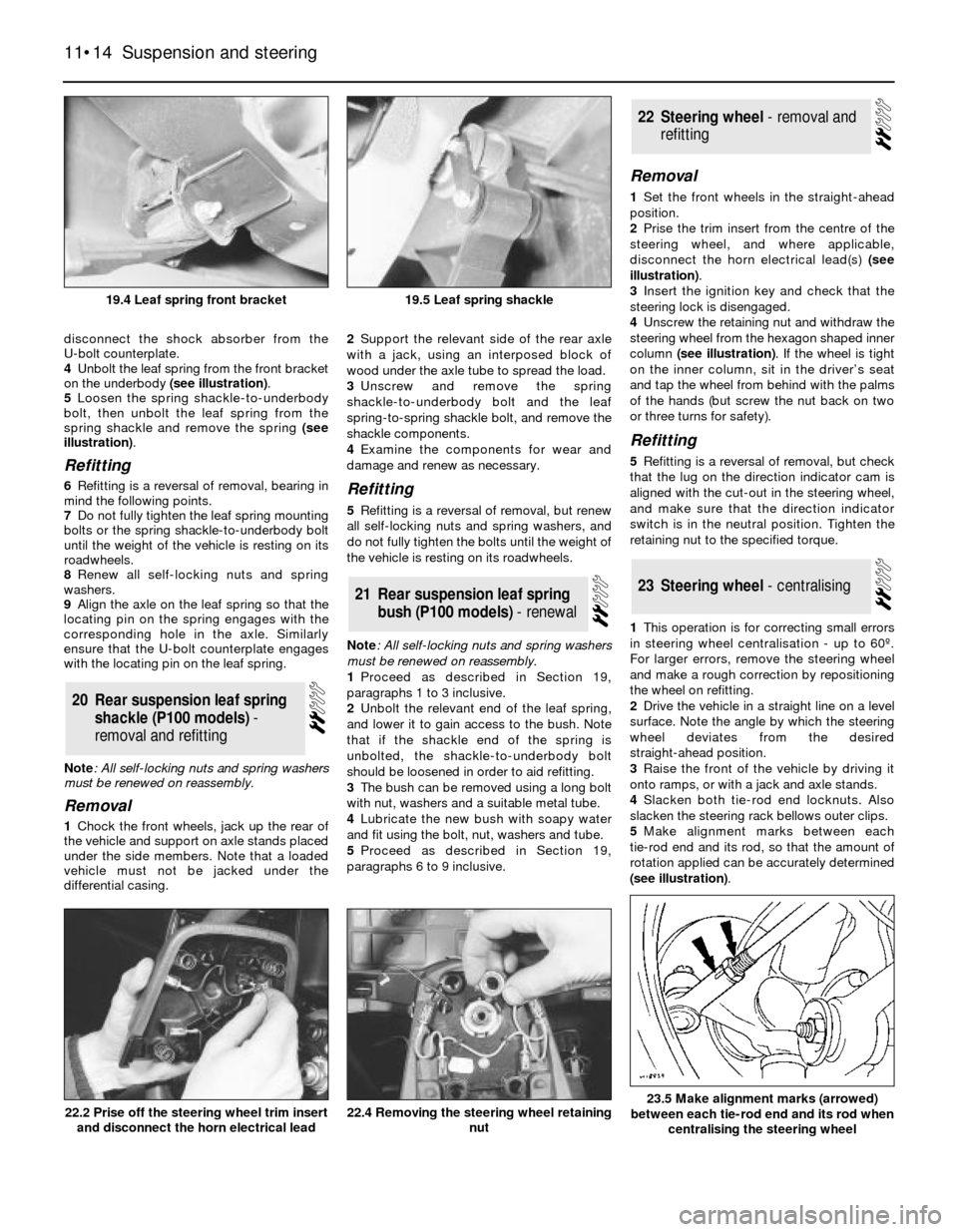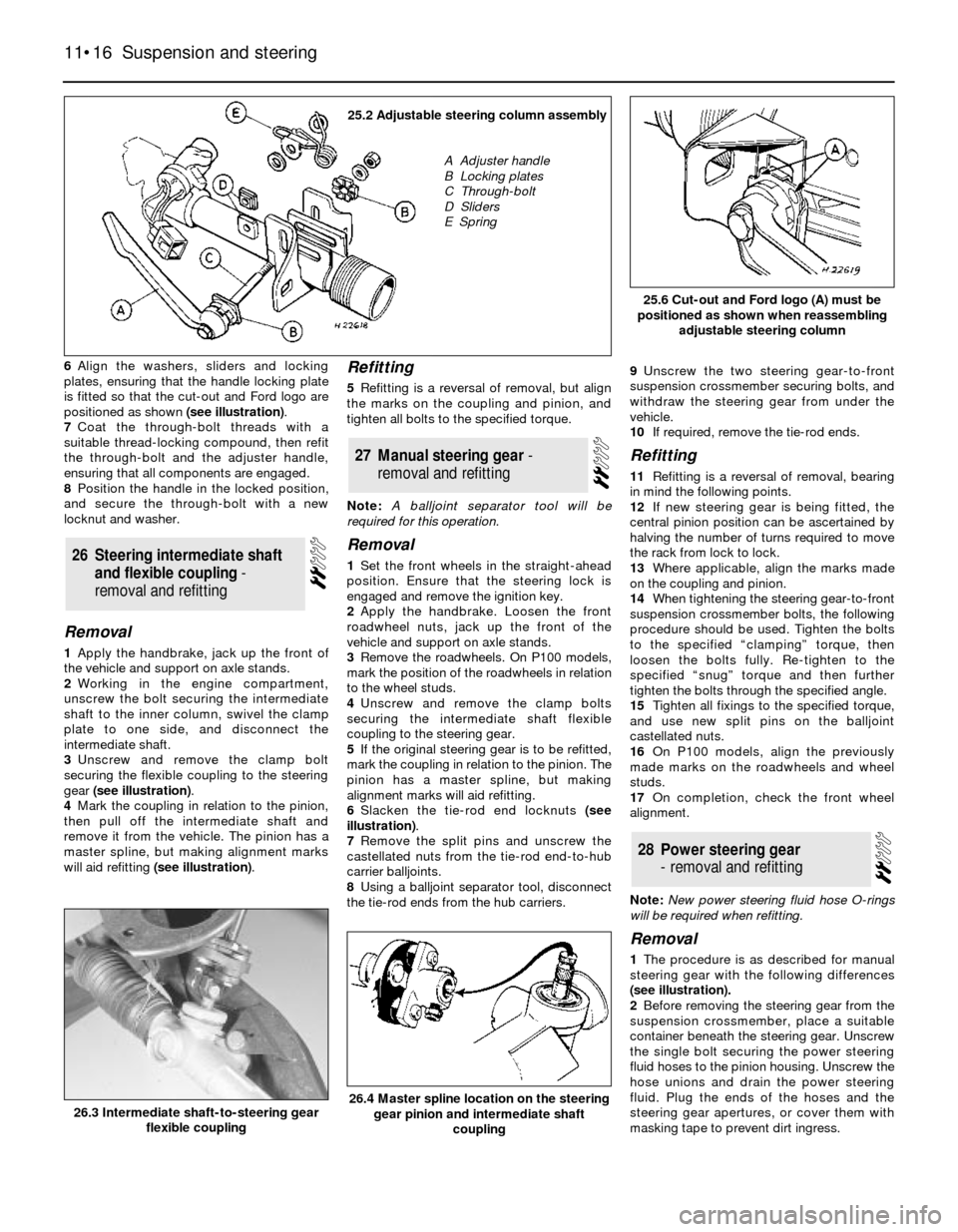key FORD SIERRA 1992 2.G Suspension And Steering Workshop Manual
[x] Cancel search | Manufacturer: FORD, Model Year: 1992, Model line: SIERRA, Model: FORD SIERRA 1992 2.GPages: 20, PDF Size: 0.94 MB
Page 5 of 20

7Working in the engine compartment,
unscrew the strut upper mounting nut, at the
same time supporting the strut from below.
Use a 6 mm Allen key inserted in the end of
the strut piston rod to prevent the rod from
turning as the upper mounting nut is
unscrewed (see illustration). On some
models, the upper mounting nut may be fitted
with a plastic cover. Note the upper mounting
cup under the nut.
8Withdraw the strut from under the wing of
the vehicle.
Overhaul
9To dismantle the strut, proceed as follows.
10Using spring compressors, compress the
coil spring. Do not attempt to compress the
spring without using purpose-made spring
compressors, as the spring is under
considerable tension, and personal injury may
occur if it is suddenly released (see
illustration).
11Hold the piston rod as described in
paragraph 7, unscrew the nut from the pistonrod and remove the lower cup, bearing, spring
seat, gaiter, coil spring and bump stop (see
illustration).
12Working in the engine compartment,
remove the upper cup and nylon spacer, and
if required prise out the rubber insulator.
13Clean all the components and examine
them for wear and damage. Check the action
of the shock absorber by mounting it vertically
in a vice and operating the piston rod several
times through its full stroke. If any uneven
resistance is evident, the shock absorber
must be renewed. Renew any worn or
damaged components as applicable.
Refitting
14Reassembly and refitting is a reversal of
dismantling and removal, bearing in mind the
following points.
15When reassembling, ensure that the gaiter
is fitted over the bump stop, and that the ends
of the coil spring are correctly located on the
spring seats. Also ensure that the bearing is
correctly located on the upper spring seat.
16Fit the nylon spacer over the piston rod
before fitting the strut to the top mounting.
17Tighten all fixings to the specified torque.
18On P100 models align the previously
made marks on the roadwheel and wheel
stud.Note: A balljoint separator tool will be
required for this operation.
Removal
1Loosen the relevant front roadwheel nuts,
apply the handbrake, jack up the front of the
vehicle and support on axle stands (see
“Jacking and Vehicle Support”).
2Remove the roadwheel. On P100 models
mark the position of the roadwheel in relation
to one of the wheel studs before removal.
3Remove the front brake caliper but do not
disconnect the hydraulic hose. Support the
caliper on an axle stand, or suspend it with wire
from the coil spring to avoid straining the hose.
4Mark the position of the brake disc in
relation to the drive flange, and on Saloon,
Hatchback and Estate models, remove the
retaining screw or spire washer(s), as
applicable, and remove the disc. On P100
models, unscrew the five retaining nuts and
remove the wheel adapter plate and disc.
5Where applicable, unbolt the ABS wheel
sensor from the hub carrier and unplug the
wiring connector. Place the sensor to one side.
6Remove the split pin and unscrew the
castellated nut securing the tie-rod end to the
hub carrier. Using a balljoint separator tool,
disconnect the tie-rod end from the hub carrier.
7Repeat the procedure given in the previous
paragraph for the lower arm-to-hub carrier
balljoint.
8Unscrew and remove the pinch-bolt which
secures the hub carrier to the strut (see
illustration). Using a suitable lever, such as a
cold chisel, lever the hub carrier clamp legs
and wedge them apart. Withdraw the hub
carrier from the strut.
Refitting
9Refitting is a reversal of removal, but use
new split pins on the castellated nuts, and
align the previously made marks on the brake
disc and hub. Tighten all fixings to the
specified torque.
10On P100 models align the previously
made marks on the roadwheel and wheel
stud.
5Front hub carrier -removaland
refitting
Suspension and steering 11•5
11
5.8 Unscrewing the hub carrier-to-strut
pinch-bolt
4.11 Cross-section of the front strut upper mounting
A Bearing
B Nylon spacer
C Upper cupD Rubber insulator
E Lower cup
F Spring seatG Bump stop
H Gaiter
4.10 Suspension strut fitted with spring
compressors
4.7 Hold the strut piston rod with a 6 mm
Allen key when unscrewing the upper
mounting nut
Page 14 of 20

disconnect the shock absorber from the
U-bolt counterplate.
4Unbolt the leaf spring from the front bracket
on the underbody (see illustration).
5Loosen the spring shackle-to-underbody
bolt, then unbolt the leaf spring from the
spring shackle and remove the spring (see
illustration).
Refitting
6Refitting is a reversal of removal, bearing in
mind the following points.
7Do not fully tighten the leaf spring mounting
bolts or the spring shackle-to-underbody bolt
until the weight of the vehicle is resting on its
roadwheels.
8Renew all self-locking nuts and spring
washers.
9Align the axle on the leaf spring so that the
locating pin on the spring engages with the
corresponding hole in the axle. Similarly
ensure that the U-bolt counterplate engages
with the locating pin on the leaf spring.
Note: All self-locking nuts and spring washers
must be renewed on reassembly.
Removal
1Chock the front wheels, jack up the rear of
the vehicle and support on axle stands placed
under the side members. Note that a loaded
vehicle must not be jacked under the
differential casing.2Support the relevant side of the rear axle
with a jack, using an interposed block of
wood under the axle tube to spread the load.
3Unscrew and remove the spring
shackle-to-underbody bolt and the leaf
spring-to-spring shackle bolt, and remove the
shackle components.
4Examine the components for wear and
damage and renew as necessary.
Refitting
5Refitting is a reversal of removal, but renew
all self-locking nuts and spring washers, and
do not fully tighten the bolts until the weight of
the vehicle is resting on its roadwheels.
Note: All self-locking nuts and spring washers
must be renewed on reassembly.
1Proceed as described in Section 19,
paragraphs 1 to 3 inclusive.
2Unbolt the relevant end of the leaf spring,
and lower it to gain access to the bush. Note
that if the shackle end of the spring is
unbolted, the shackle-to-underbody bolt
should be loosened in order to aid refitting.
3The bush can be removed using a long bolt
with nut, washers and a suitable metal tube.
4Lubricate the new bush with soapy water
and fit using the bolt, nut, washers and tube.
5Proceed as described in Section 19,
paragraphs 6 to 9 inclusive.
Removal
1Set the front wheels in the straight-ahead
position.
2Prise the trim insert from the centre of the
steering wheel, and where applicable,
disconnect the horn electrical lead(s) (see
illustration).
3Insert the ignition key and check that the
steering lock is disengaged.
4Unscrew the retaining nut and withdraw the
steering wheel from the hexagon shaped inner
column (see illustration). If the wheel is tight
on the inner column, sit in the driver’s seat
and tap the wheel from behind with the palms
of the hands (but screw the nut back on two
or three turns for safety).
Refitting
5Refitting is a reversal of removal, but check
that the lug on the direction indicator cam is
aligned with the cut-out in the steering wheel,
and make sure that the direction indicator
switch is in the neutral position. Tighten the
retaining nut to the specified torque.
1This operation is for correcting small errors
in steering wheel centralisation - up to 60º.
For larger errors, remove the steering wheel
and make a rough correction by repositioning
the wheel on refitting.
2Drive the vehicle in a straight line on a level
surface. Note the angle by which the steering
wheel deviates from the desired
straight-ahead position.
3Raise the front of the vehicle by driving it
onto ramps, or with a jack and axle stands.
4Slacken both tie-rod end locknuts. Also
slacken the steering rack bellows outer clips.
5Make alignment marks between each
tie-rod end and its rod, so that the amount of
rotation applied can be accurately determined
(see illustration).
23Steering wheel - centralising
22Steering wheel - removal and
refitting
21Rear suspension leaf spring
bush (P100 models) - renewal
20Rear suspension leaf spring
shackle (P100 models) -
removal and refitting
11•14Suspension and steering
19.5 Leaf spring shackle
22.4 Removing the steering wheel retaining
nut22.2 Prise off the steering wheel trim insert
and disconnect the horn electrical lead
19.4 Leaf spring front bracket
23.5 Make alignment marks (arrowed)
between each tie-rod end and its rod when
centralising the steering wheel
Page 16 of 20

6Align the washers, sliders and locking
plates, ensuring that the handle locking plate
is fitted so that the cut-out and Ford logo are
positioned as shown (see illustration).
7Coat the through-bolt threads with a
suitable thread-locking compound, then refit
the through-bolt and the adjuster handle,
ensuring that all components are engaged.
8Position the handle in the locked position,
and secure the through-bolt with a new
locknut and washer.
Removal
1Apply the handbrake, jack up the front of
the vehicle and support on axle stands.
2Working in the engine compartment,
unscrew the bolt securing the intermediate
shaft to the inner column, swivel the clamp
plate to one side, and disconnect the
intermediate shaft.
3Unscrew and remove the clamp bolt
securing the flexible coupling to the steering
gear (see illustration).
4Mark the coupling in relation to the pinion,
then pull off the intermediate shaft and
remove it from the vehicle. The pinion has a
master spline, but making alignment marks
will aid refitting (see illustration).
Refitting
5Refitting is a reversal of removal, but align
the marks on the coupling and pinion, and
tighten all bolts to the specified torque.
Note: A balljoint separator tool will be
required for this operation.
Removal
1Set the front wheels in the straight-ahead
position. Ensure that the steering lock is
engaged and remove the ignition key.
2Apply the handbrake. Loosen the front
roadwheel nuts, jack up the front of the
vehicle and support on axle stands.
3Remove the roadwheels. On P100 models,
mark the position of the roadwheels in relation
to the wheel studs.
4Unscrew and remove the clamp bolts
securing the intermediate shaft flexible
coupling to the steering gear.
5If the original steering gear is to be refitted,
mark the coupling in relation to the pinion. The
pinion has a master spline, but making
alignment marks will aid refitting.
6Slacken the tie-rod end locknuts (see
illustration).
7Remove the split pins and unscrew the
castellated nuts from the tie-rod end-to-hub
carrier balljoints.
8Using a balljoint separator tool, disconnect
the tie-rod ends from the hub carriers.9Unscrew the two steering gear-to-front
suspension crossmember securing bolts, and
withdraw the steering gear from under the
vehicle.
10If required, remove the tie-rod ends.
Refitting
11Refitting is a reversal of removal, bearing
in mind the following points.
12If new steering gear is being fitted, the
central pinion position can be ascertained by
halving the number of turns required to move
the rack from lock to lock.
13Where applicable, align the marks made
on the coupling and pinion.
14When tightening the steering gear-to-front
suspension crossmember bolts, the following
procedure should be used. Tighten the bolts
to the specified “clamping” torque, then
loosen the bolts fully. Re-tighten to the
specified “snug” torque and then further
tighten the bolts through the specified angle.
15Tighten all fixings to the specified torque,
and use new split pins on the balljoint
castellated nuts.
16On P100 models, align the previously
made marks on the roadwheels and wheel
studs.
17On completion, check the front wheel
alignment.
Note: New power steering fluid hose O-rings
will be required when refitting.
Removal
1The procedure is as described for manual
steering gear with the following differences
(see illustration).
2Before removing the steering gear from the
suspension crossmember, place a suitable
container beneath the steering gear. Unscrew
the single bolt securing the power steering
fluid hoses to the pinion housing. Unscrew the
hose unions and drain the power steering
fluid. Plug the ends of the hoses and the
steering gear apertures, or cover them with
masking tape to prevent dirt ingress.
28Power steering gear
- removal and refitting
27Manual steering gear -
removaland refitting
26Steering intermediate shaft
and flexible coupling -
removal and refitting
11•16Suspension and steering
25.6 Cut-out and Ford logo (A) must be
positioned as shown when reassembling
adjustable steering column
26.4 Master spline location on the steering
gear pinion and intermediate shaft
coupling26.3 Intermediate shaft-to-steering gear
flexible coupling
25.2 Adjustable steering column assembly
A Adjuster handle
B Locking plates
C Through-bolt
D Sliders
E Spring